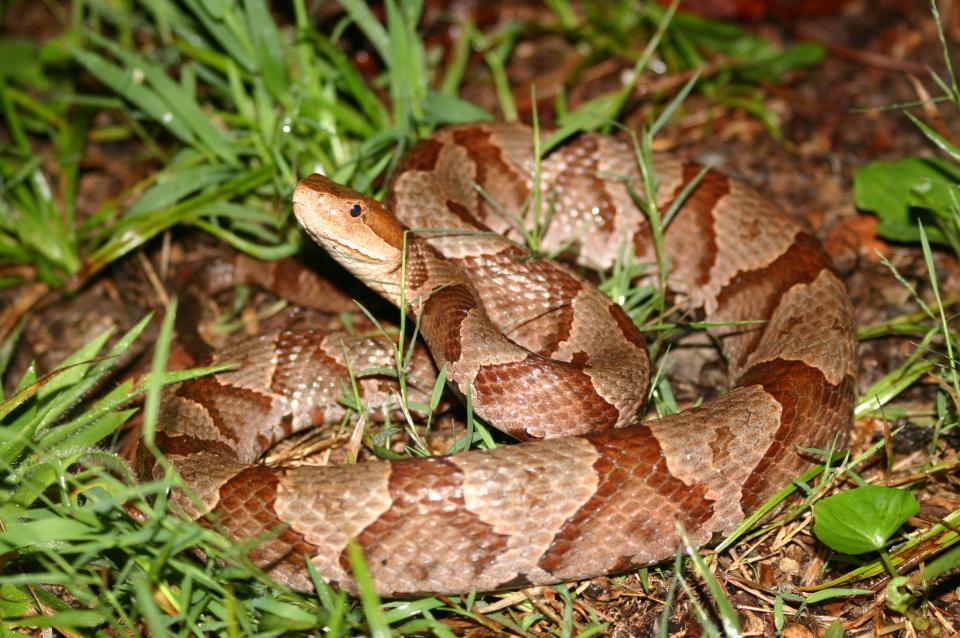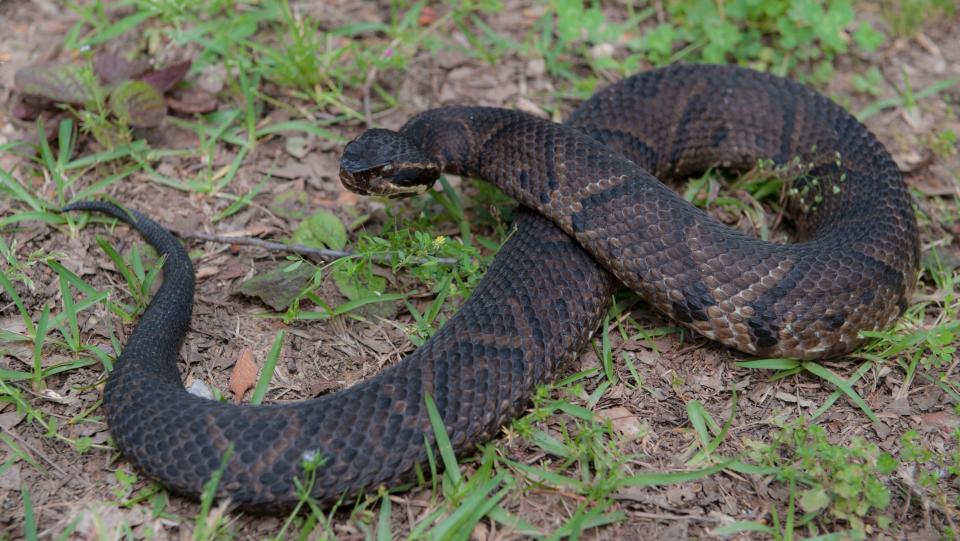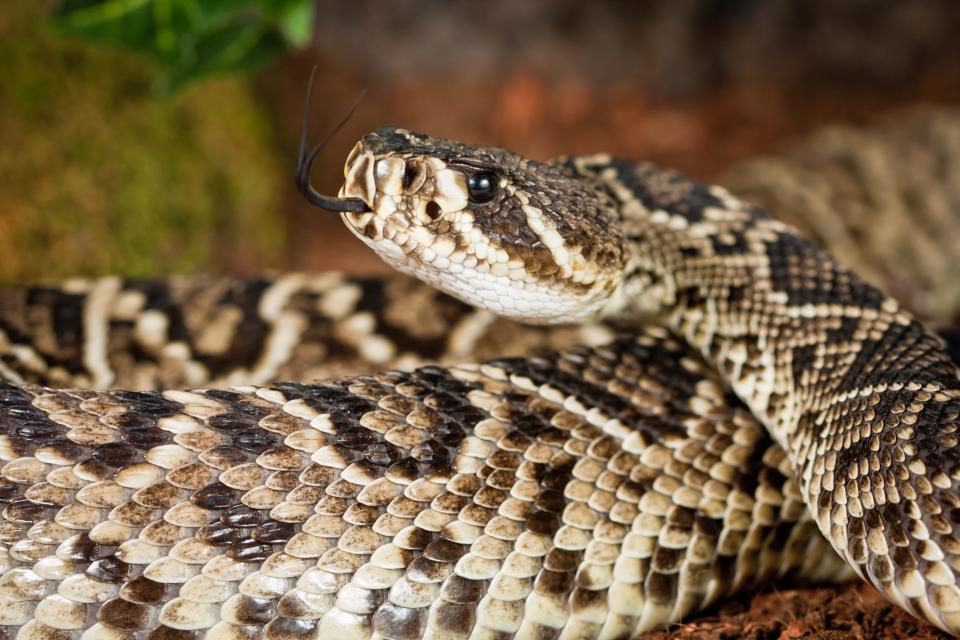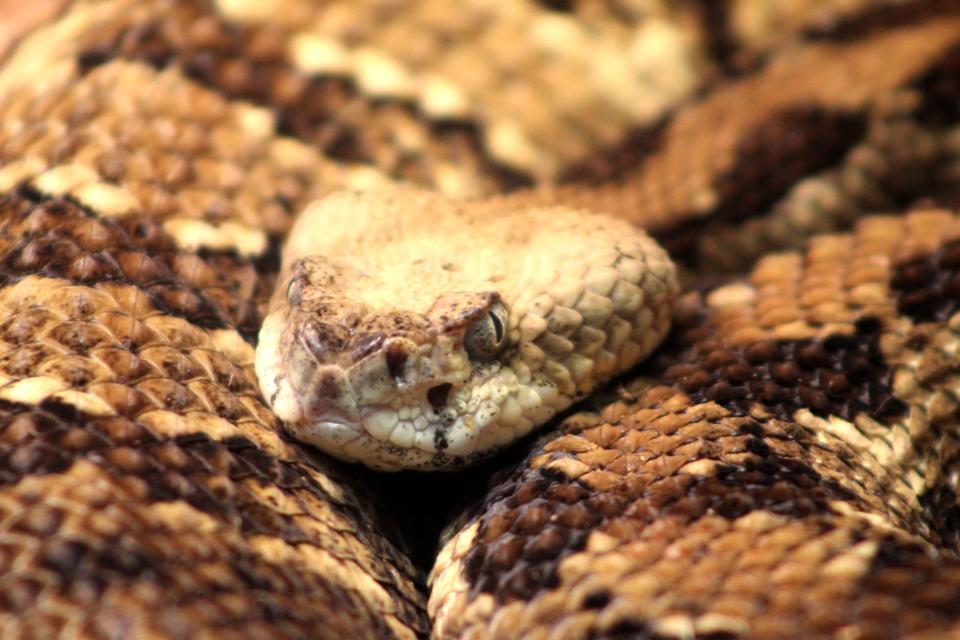5 venomous snakes in NC, Asheville: What to know about rattlesnakes, copperheads, more
As it warms up in North Carolina, many plants, animals and insects are waking up for the season. While N.C. residents begin enjoying outdoor activities again, it's important to know what to look out for in nature in order to stay safe.
One risk when enjoying the great outdoors is the potential for snake bites. There are six species of venomous snakes in N.C., and NC Poison Control says that five of these are responsible for a majority of snake bite envenomations.
Here's what to know about the five most common species of venomous snakes in N.C., their habitats and the severity of their bites.
American copperhead

Appearance: Adult copperheads are usually about 3 feet in length. The snakes are light brown with a contrasting dark brown, hourglass-shaped pattern often compared to Hershey's Kisses. Young snakes, which can be significantly more dangerous, often have yellow tail tips.
Habitat: Copperheads are the most common venomous snake in the state, living all across N.C. Poison Control says that it receives about 10 times more calls about copperheads than any other snake. The North Carolina Wildlife Resources Commission says that copperheads prefer areas with both cover and sun for basking, such as woodland edges. They can often be found in sawdust piles, stacks of firewood, trash dumps and more.
Bite severity: The good news that many aren't aware of is that copperhead bites, while very painful, often pose very little risk. In fact, Poison Control says that about half of all bites result only in pain and mild swelling. Of course, you should still contact NC Poison Control or a medical professional immediately if bitten.
More: Do cicadas really attract copperheads? What to know about emergences in Asheville area
Cottonmouth (water moccasin)

Appearance: Cottonmouths are also about 3 feet in length, with dark crossband patterns that have light brown centers. As per their name, they are known for the contrasting white, cotton-like color inside of their mouths.
Habitat: Found in the eastern parts of N.C., these snakes prefer freshwater areas but can also be found on land.
Bite severity: Similar to a copperhead, severe but usually not as severe as other venomous N.C. snakes. Symptoms of their venom is similar to those present in copperhead bites.
More: Tick-borne diseases on the rise: Here's what to know about tick season in Asheville, NC
Eastern diamondback rattlesnake

Appearance: Eastern diamondback rattlesnakes are the world's longest and heaviest rattlesnakes, measuring up to 6x feet in length. They can be dark gray or olive green, and are identifiable by the distinctive diamond-shaped markings on their backs. Also distinctive are black bands outlined by two pale lines that cover the snakes' eye areas.
Habitat: Sandy, coastal areas in southeast N.C.
Bite severity: Much more severe than bites from copperheads and cottonmouths, all rattlesnake bites are considered medical emergencies. Their venom contains hemotoxins, meaning it kills red blood cells, but deaths from their bites are rare due to the availability of effective antivenom.
More: Answer Man: Dogs not allowed in local cafes? Health department rules against dogs inside?
Timber rattlesnake

Appearance: Timber rattlesnakes vary in size and color, but can be recognized by their dark banded pattern on lighter skin, as well as the rattle at the end of its tail. NC Poison Control says that coastal varieties generally have a brown or orange stripe down the middle of their backs.
Habitat: One of the two snakes on this list found in Western North Carolina, timber rattlesnakes are found in the western, south central and eastern parts of the state.
Bite severity: Similar to Eastern diamondback rattlesnakes, timber rattlesnake bites are medical emergencies and can cause death if not treated by antivenom.
More: Still pregnant: Charlotte the stingray has not had 'miracle' birth as fans grow impatient
Carolina pigmy rattlesnake
Appearance: Pigmy rattlesnakes, as the name implies, are relatively small, around 1 or 2 feet in length. They have dark gray spotted patterns on gray, pink or red skin. NC Poison Control says that their rattle sounds more like a buzz than many rattlesnakes.
Habitat: The Wildlife Commission says pigmy rattlesnakes mainly live in pine flatwoods and scrub oak habitats in southeastern Coastal Plain, Sandhills and a few portions of the southern Piedmont.
Bite severity: Due in part to their small size, bites from these snakes are often less serious than many other rattlesnake bites. However, NC Poison Control reminds residents that any rattlesnake bite is generally more severe than a bite from other venomous N.C. snake types. Pigmy rattlesnake bites are medical emergencies that require immediate treatment.
More: Explore Worldwide names Great Smoky Mountains as 2024’s top trending park; Here's why
Iris Seaton is the trending news reporter for the Asheville Citizen Times, part of the USA TODAY Network. Reach her at iseaton@citizentimes.com.
This article originally appeared on Asheville Citizen Times: 5 venomous snakes in NC. How deadly is a copperhead?

